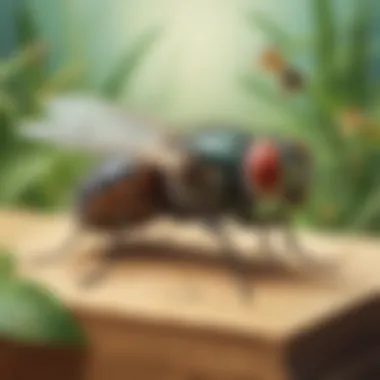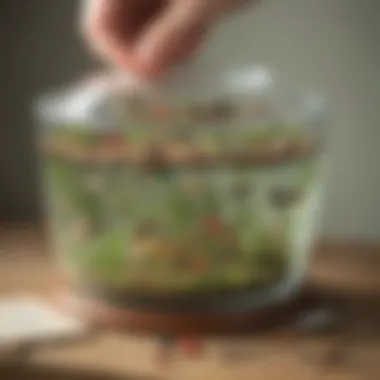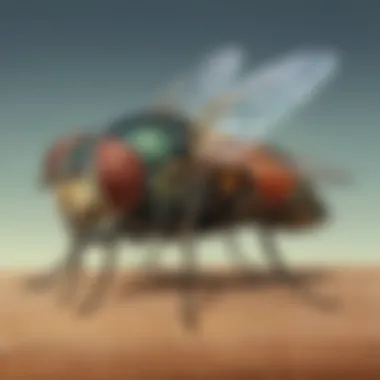Ultimate Guide to Crafting an Effective DIY Fly Killer


Science Fun Facts
Fly killer concoctions have been used for centuries to combat pesky insects, with ancient civilizations developing innovative methods to keep their surroundings insect-free. In some cultures, aromatic herbs were burned to deter flies, showcasing early examples of natural insect repellents.
While flies are often viewed as nuisances, they play an essential role in ecosystems by aiding in decomposing organic matter. However, their rapid reproduction rates can lead to infestations if not controlled effectively, making fly killer solutions crucial for maintaining hygienic living environments.
Discover the Wonders of Science
Exploring the science behind fly behavior unveils fascinating insights into their sensory capabilities and survival instincts. Flies are attracted to various stimuli, including food odors and moisture, guiding their foraging behavior and choice of breeding sites.
When attempting to create an effective fly killer, understanding the mechanisms that drive fly attraction and repulsion is crucial. By leveraging scientific principles to disrupt their sensory pathways, homemade traps can be designed to intercept and eliminate flies efficiently.
Science Experiment Showcase
Embarking on a DIY fly killer experiment opens doors to hands-on learning experiences for aspiring young scientists. By following step-by-step instructions and utilizing common household materials, children can actively engage in the process of constructing traps and observing fly behavior.
Materials such as vinegar, dish soap, and sugar can be combined to create a potent fly attractant, enticing flies into traps where they meet their demise. Safety precautions, including handling sharp objects with care and avoiding ingestion of ingredients, ensure a secure and supervised experimental environment.
Moreover, documenting observations and outcomes from fly killer experiments cultivates critical thinking skills and nurtures a curiosity for scientific exploration in young minds. By combining creativity with scientific inquiry, children can develop a deeper appreciation for the multifaceted world of entomology and pest control.
Understanding Flies
Understanding flies is crucial in the context of this article as it lays the foundation for effective fly control measures. By comprehending the behavioral patterns of flies, we can identify their weaknesses and devise strategies to counteract them. This knowledge is essential for creating efficient fly traps and repellents, ultimately aiding in the maintenance of a fly-free environment.
Behavioral Patterns of Flies
Feeding Habits
Flies have distinct feeding habits that play a significant role in their survival and reproduction. Their preference for decaying organic matter, feces, and sugary substances makes them not only a nuisance but also potential carriers of diseases. Understanding their feeding habits is key to luring them into traps effectively. By utilizing this knowledge, we can target their attraction to specific baits, increasing the traps' efficacy in capturing and eliminating flies.


Breeding Sites
The choice of breeding sites significantly impacts the population growth of flies. By being attracted to moist, warm environments with ample food sources, flies tend to reproduce rapidly in such locations. Recognizing common breeding sites like garbage bins, compost heaps, and drains allows us to disrupt their reproductive cycle by targeting and eliminating these locations. This understanding is crucial for implementing control measures that target fly larvae, thus preventing future fly infestations.
Common Fly Species
Houseflies
Houseflies are one of the most prevalent fly species found in homes and urban areas. Their rapid breeding cycle and affinity for human habitats make them a primary target for fly control efforts. Utilizing insights into houseflies' behavior and preferences, we can develop targeted strategies such as fly traps and repellents specifically tailored to eliminate this species.
Fruit Flies
Fruit flies are attracted to ripening fruits and vegetables, making them a common nuisance in kitchens and pantries. Their small size and quick reproduction make them challenging to control once they infest a space. Understanding the habits of fruit flies allows us to set up traps with bait that mimics their preferred food sources, effectively reducing their numbers and preventing further infestation.
Cluster Flies
Cluster flies are known for their habit of seeking shelter in large numbers during the colder months, often congregating in attics and wall voids. Their presence can be unsettling and challenging to eradicate once established indoors. By understanding cluster flies' behavior, we can employ targeted methods to prevent their entry into buildings and eliminate existing populations, ensuring a fly-free living environment.
Creating DIY Fly Traps
Creating DIY Fly Traps serves as a fundamental aspect in the quest for an effective fly killer. By crafting homemade traps, one can actively combat fly infestations using simple yet potent ingredients and methods. These traps offer a natural and budget-friendly solution to address the nuisance of flies in indoor spaces, promoting a clean and pest-free environment. Emphasizing the significance of this topic underscores the practicality and efficiency of DIY approaches to pest control.
Ingredients for Homemade Fly Traps
Apple Cider Vinegar
Apple Cider Vinegar plays a pivotal role in attracting and trapping flies due to its strong scent and acidic nature. Its distinct aroma acts as a potent lure, enticing flies into the trap. The acidity of Apple Cider Vinegar further aids in breaking down compounds that may interest flies, effectively trapping them. While highly effective in fly control, a potential drawback of Apple Cider Vinegar lies in its strong smell, which some may find off-putting.
Sugar


Sugar acts as a supplementary attractant in homemade fly traps, providing an additional incentive for flies to investigate and enter the trap. The sweetness of sugar enhances the appeal of the trap, especially for flies drawn to sugary substances. This ingredient works synergistically with other components to maximize trap effectiveness. However, excessive use of sugar may lead to unwanted attraction of other insects.
Dish Soap
Dish Soap plays a crucial role in enhancing the effectiveness of fly traps by reducing the surface tension of the liquid. When added to the trap mixture, dish soap disrupts the surface tension, causing flies to sink and drown upon contact with the solution. This feature ensures that captured flies cannot escape once they land in the trap. While dish soap improves trap efficiency, excessive use may result in excessive sudsing.
Methods of Making Fly Traps
Jar Trap
The Jar Trap method involves using a container, preferably a glass jar, filled with a mixture of Apple Cider Vinegar, sugar, and dish soap. Flies are lured by the scent of the ingredients and subsequently fall into the solution due to the disrupted surface tension, preventing their escape. The transparency of the jar allows for easy monitoring of trapped flies, facilitating trap maintenance.
Paper Cone Trap
The Paper Cone Trap is constructed by creating a cone-shaped funnel with a small opening at the tip, placed atop a jar filled with the trapping solution. Flies enter the trap through the wide end of the cone but struggle to find their way out due to the narrowing passage. This trap design effectively captures flies while ensuring they cannot easily fly back out.
Plastic Bottle Trap
The Plastic Bottle Trap involves repurposing a plastic bottle by cutting the top portion to create a funnel-like structure that leads into the main body of the bottle. Flies are attracted into the trap by the lure of the ingredients and become trapped inside the bottle. This method is cost-effective and can be easily deployed in various locations.
Placement and Maintenance
Strategic Placement
Strategic Placement of DIY fly traps is essential for maximizing their effectiveness. Positioning traps near known fly-infested areas, such as garbage bins or kitchen countertops, increases their efficiency in trapping and reducing the fly population. Placing traps away from frequently used areas minimizes human interference while ensuring flies are drawn to the traps.
Changing the Bait Regularly
Regularly changing the bait in fly traps is crucial for sustained efficacy. Flies may become accustomed to a particular scent over time, reducing the trap's effectiveness. By changing the bait regularly, one can ensure that the traps remain attractive to flies, enhancing their capture rate. This maintenance practice prolongs the trap's utility and promotes continuous fly control.


Natural Repellents for Flies
In the quest to eradicate flies from your surroundings, employing natural repellents proves to be a strategic move. Natural repellents offer a chemical-free alternative, ensuring the safety of children, parents, and caregivers alike. By harnessing the innate properties of plants and essential oils, you can effectively ward off flies without resorting to harmful toxins. Understanding the significance of natural repellents is crucial in maintaining a fly-free environment and promoting a healthier living space.
Plants with Fly-Repelling Properties
- Lavender: Embracing the sweet fragrance and potent properties of lavender can serve as a formidable deterrent against pesky flies. Lavender stands out for its calming aroma, often used in aromatherapy to relax and rejuvenate. In the war against flies, lavender's distinct scent acts as a formidable shield, driving these insects away. Its versatility extends beyond repelling flies, doubling as a decorative and aromatic addition to your living quarters. While lavender boasts numerous benefits, its drawbacks are minimal, making it a must-have in your arsenal against flies.
- Basil: Delving into the world of basil reveals a powerhouse of fly-repelling capabilities. Basil's strong aroma and antimicrobial properties make it a natural choice to combat flies effectively. This herb's resilience against pests makes it a sustainable solution for fly infestations. Incorporating basil into your environment not only deters flies but also adds a touch of freshness to the air. Despite its efficacy, basil does require regular maintenance to harness its full potential in fly prevention.
- Mint: Unveiling the secrets of mint exposes a refreshing and formidable ally in the battle against flies. Mint's invigorating scent acts as a potent repellant, keeping flies at bay. Its rapid growth and hardy nature make it an accessible and reliable option for fly control. Mint's cooling properties extend beyond flavoring dishes to thwarting flies from invading your space. While mint's benefits are plentiful, its invasive growth tendencies may necessitate careful containment to prevent it from overtaking your surroundings.
Essential Oils as Fly Repellents
Harnessing the power of essential oils as fly repellents introduces a holistic approach to fly control, enriching your living environment with natural scents and potent fly-deterring properties. Essential oils offer a versatile and aromatic solution to tackle fly infestations without compromising on indoor air quality.
- Peppermint Oil: Embracing the invigorating essence of peppermint oil provides a dual-purpose solution for combating flies effortlessly. Peppermint oil's potent aroma not only freshens the air but also acts as a potent fly repellent. Its versatility allows for multiple applications, from DIY repellent sprays to diffusers, ensuring flies find your space inhospitable. However, the high concentration of peppermint oil may require dilution to prevent overwhelming sensitive individuals or pets.
- Eucalyptus Oil: Unveiling the refreshing attributes of eucalyptus oil unveils a robust fly-repellent with strong antibacterial properties. Eucalyptus oil's crisp scent serves as a formidable barrier against flies, discouraging their presence. Its antibacterial qualities contribute to a cleaner environment while deterring pests simultaneously. The versatility of eucalyptus oil extends to creating custom blends for targeted fly control, amplifying its efficacy in safeguarding your space against unwanted intruders.
- Lemon Oil: Exploring the zesty fragrance of lemon oil reveals a multipurpose fly deterrent that uplifts your surroundings with a citrusy aroma. Lemon oil's bright scent not only freshens the air but also repels flies effectively. Its astringent properties make it a potent solution for maintaining a fly-free environment while invigorating your senses. Lemon oil's versatility lends itself to various applications, whether in DIY repellent sprays or diffusers, offering a natural and pleasant alternative to conventional fly control methods.
Maintaining a Fly-Free Environment
Maintaining a fly-free environment is crucial for a clean and healthy living space. By implementing effective strategies to keep flies at bay, you can prevent the spread of diseases and ensure a more comfortable environment. Regular maintenance and proper sanitation practices play a key role in achieving this goal, making it essential to focus on maintaining a fly-free space.
Regular Cleaning Practices
Proper Waste Disposal
Proper waste disposal is a fundamental aspect of maintaining a fly-free environment. By disposing of waste promptly and correctly, you eliminate potential breeding grounds for flies. Ensuring that garbage bins are tightly sealed and regularly emptied can significantly reduce the presence of flies. Proper waste disposal not only controls fly populations but also helps in preventing foul odors and contamination, promoting a hygienic living environment.
Clean Food Storage
Clean food storage is another critical element in the fight against flies. Storing food items in airtight containers and maintaining cleanliness in kitchen areas minimizes the attraction of flies to food sources. By eliminating open food containers and spills, you disrupt the access points for flies, reducing the likelihood of infestations. Clean food storage practices not only deter flies but also contribute to overall food safety and hygiene, protecting against contamination and health risks.
Sealing Entry Points
Window Screens
Installing window screens is a proactive measure to prevent flies from entering indoor spaces. Window screens act as barriers, blocking fly intrusion while allowing ventilation. By ensuring that window screens are intact and properly fitted, you create a barrier that keeps flies out without compromising airflow. Window screens are an effective and non-invasive way to limit fly entry, promoting a pest-free environment.
Door Sweeps
Door sweeps are essential components in sealing entry points and preventing fly ingress. These weather-stripping devices are installed at the base of doors to create a tight seal, closing off gaps that flies could exploit to enter buildings. Door sweeps deter flies from slipping through door gaps, enhancing the overall barrier against pests. By investing in door sweeps and regularly maintaining them, you enhance the integrity of your home's defense against flies, contributing to a fly-free indoor environment.







